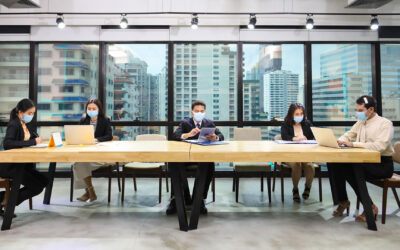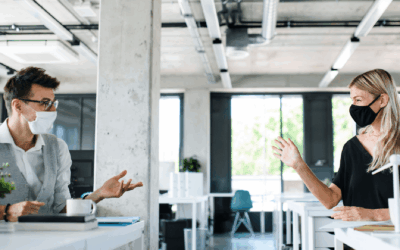As businesses continue to move out of the triage stage, into post-quarantine, and begin to grapple with complex operational hurdles associated with reopening, it’s apparent that the process will be neither simple nor without challenges.
Understanding what’s happening in the marketplace, what priorities need to be addressed, and what strategies are available to address those priorities, is a critical first step in preparing for the “re-grand opening” that tenants and landlords are looking forward to.
What follows are some of the key considerations for commercial real estate owners and operators to take into account before opening the doors and getting back to business.
Overcommunicate
At a time when so much has changed—and will continue to change—there is no such thing as overcommunicating. It starts with connecting directly with tenants about roles and responsibilities (more on that later), but also means communicating clearly to employees, visitors and guests. New and updated signage is an important piece of that puzzle, with clear visual guidance about everything from entry requirements and social distancing reminders, to wayfinding and directional signage to ensure safe and spaced-out circulation patterns. Signage will be needed to clarify recommended occupancy limit in tenant spaces, common areas, elevators and restrooms.
It might seem counterintuitive, but overcommunicating doesn’t mean dumping a massive phonebook-sized manual on a tenant’s desk. Overly detailed direction can be confusing, opaque, and can even lead to liability issues. Keep all communication clear, simple and straightforward on a single sheet of paper.
Address cleanliness and health safety basics
There is a long checklist of basic health and safety items and priorities that will need to be addressed prior to opening. That list includes:
- Featuring more touchless items in common areas.
- Ensuring that landlords have sufficient masks and other necessary personal protective equipment (PPE) for on-site employees—as well as making sure that vendors are providing their own on-site personnel with PPE.
- Have a plan in place to ensure that common areas, restrooms and other shared spaces and high-touch-point areas are cleaned more often. Address staffing and cleaning equipment that will be needed to execute that plan—including logistical issues like equipment storage, additional financial compensation for cleaning staff, etc.
- Make sure that any plan you devise satisfies all relevant local, state and federal regulatory guidelines and recommendations.
Clarify boundaries and responsibilities
Clarify roles and responsibilities about what changes and services landlords will provide, and what tenants will be expected to cover. This is especially important for costly new requirements (e.g. “all tenants will be expected to provide masks for employees, and those employees will need to wear those masks at all times when in common areas”). When it comes to cleaning, landlords can be expected to comply with official regulatory standards (including new signage and extra cleaning services in common areas), but anything beyond that is something that tenants will be expected to foot the bill for. Temperature monitoring, and other enhanced space security and access protocol, will also be the tenants’ responsibility. Landlords should, however, be prepared to provide contact information for any specialized services that tenants would like to implement. To minimize liability exposure, landlords may want to consider having tenants, vendors and guests sign a standard waiver acknowledging the steps that have been taken, and the responsibility they uphold by being on site.
Reimagine and reconfigure
While thoughtful procedural steps—such as reducing the number of people going back to work, or limiting the number of people allowed in common office areas—are important, there are also a number of structural changes and reconfiguration measures that could make a difference in reducing the health and safety risks to occupants.
Those include:
- Raising the height of cubicles and spacing out personal work areas.
- Shutting down conference rooms or reconfiguring those spaces for individual work.
- Eliminating guest chairs in waiting areas.
- Ensuring any shared furniture is made of materials that are easy to clean and disinfect.
- Updating HVAC systems (while replacing whole HVAC systems is likely to be prohibitively expensive, management and maintenance teams may be able to adjust HVAC systems to allow more outside air into the system or to optimize circulation for health and safety).
Don’t confront—connect
Finally, when considering how to enforce new guidelines and restrictions about wearing masks, or limiting the number of people gathering in certain spaces, make sure that both formal and informal guidelines emphasize the value of proceeding with a light touch. Whether an issue is with a tenant or a visitor/guest/customer, there is little to be gained by aggressive confrontation. If someone is not observing clearly marked or stated health and safety guidelines, a simple clarification and polite request to address the issue is likely to be more effective—and to avoid disruption or disputes. While not every tense interaction is avoidable, all parties involved should be focused on using this as an opportunity to build relationships, not break them.
Education, communication, and collaboration will be critical as landlords and tenants navigate this unfamiliar new landscape, and work to create professional environments that are safe and productive in a post-COVID world.
Michael Kalil is the COO of Southfield-based Farbman Group, a leading full-service real estate firm with Midwest expertise and a global reach. The firm handles all facets of real estate transactions, from property management and leasing to acquisition and disposition. For more information, visit www.farbman.com.




